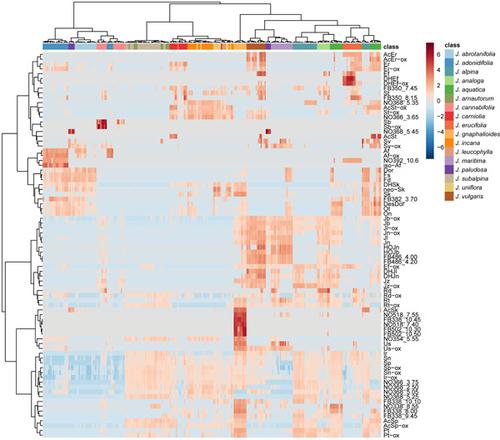当前位置:
X-MOL 学术
›
J. Syst. Evol.
›
论文详情
Our official English website, www.x-mol.net, welcomes your
feedback! (Note: you will need to create a separate account there.)
The evolution of pyrrolizidine alkaloid diversity among and within Jacobaea species
Journal of Systematics and Evolution ( IF 3.4 ) Pub Date : 2020-08-08 , DOI: 10.1111/jse.12671 Yangan Chen 1 , Patrick P. J. Mulder 2 , Onno Schaap 1 , Johan Memelink 1 , Peter G. L. Klinkhamer 1 , Klaas Vrieling 1
Journal of Systematics and Evolution ( IF 3.4 ) Pub Date : 2020-08-08 , DOI: 10.1111/jse.12671 Yangan Chen 1 , Patrick P. J. Mulder 2 , Onno Schaap 1 , Johan Memelink 1 , Peter G. L. Klinkhamer 1 , Klaas Vrieling 1
Affiliation

|
Plants produce many secondary metabolites showing considerable inter- and intraspecific diversity of concentration and composition as a strategy to cope with environmental stresses. The evolution of plant defenses against herbivores and pathogens can be unraveled by understanding the mechanisms underlying chemical diversity. Pyrrolizidine alkaloids are a class of secondary metabolites with high diversity. We performed a qualitative and quantitative analysis of 80 pyrrolizidine alkaloids with liquid chromatography-tandem mass spectrometry of leaves from 17 Jacobaea species including one to three populations per species with 4–10 individuals per population grown under controlled conditions in a climate chamber. We observed large inter- and intraspecific variation in pyrrolizidine alkaloid concentration and composition, which were both species-specific. Furthermore, we sequenced 11 plastid and three nuclear regions to reconstruct the phylogeny of the 17 Jacobaea species. Ancestral state reconstruction at the species level showed mainly random distributions of individual pyrrolizidine alkaloids. We found little evidence for phylogenetic signals, as nine out of 80 pyrrolizidine alkaloids showed a significant phylogenetic signal for Pagel's λ statistics only, whereas no significance was detected for Blomberg's K measure. We speculate that this high pyrrolizidine alkaloid diversity is the result of the upregulation and downregulation of specific pyrrolizidine alkaloids depending on ecological needs rather than gains and losses of particular pyrrolizidine alkaloid biosynthesis genes during evolution.
中文翻译:

Jacobaea 物种之间和内部的吡咯里西啶生物碱多样性的演变
植物产生许多次生代谢物,作为应对环境压力的一种策略,它们表现出相当大的种间和种内浓度和组成多样性。通过了解化学多样性背后的机制,可以揭示植物对食草动物和病原体的防御进化。吡咯里西啶生物碱是一类具有高度多样性的次级代谢产物。我们使用液相色谱-串联质谱法对 17 个Jacobaea的叶子进行了 80 种吡咯里西啶生物碱的定性和定量分析物种包括每个物种一到三个种群,每个种群在气候室的受控条件下生长 4-10 个个体。我们观察到吡咯里西啶生物碱浓度和组成的种间和种内变化很大,这都是物种特异性的。此外,我们对 11 个质体和三个核区域进行了测序,以重建 17 个Jacobaea物种的系统发育。物种水平的祖先状态重建主要显示单个吡咯里西啶生物碱的随机分布。我们几乎没有发现系统发育信号的证据,因为 80 种吡咯里西啶生物碱中有 9 种仅对 Pagel 的λ统计显示出显着的系统发育信号,而 Blomberg 的K没有检测到显着性信号。措施。我们推测这种高吡咯里西啶生物碱多样性是特定吡咯里西啶生物碱根据生态需要上调和下调的结果,而不是进化过程中特定吡咯里西啶生物碱生物合成基因的得失。
更新日期:2020-08-08
中文翻译:

Jacobaea 物种之间和内部的吡咯里西啶生物碱多样性的演变
植物产生许多次生代谢物,作为应对环境压力的一种策略,它们表现出相当大的种间和种内浓度和组成多样性。通过了解化学多样性背后的机制,可以揭示植物对食草动物和病原体的防御进化。吡咯里西啶生物碱是一类具有高度多样性的次级代谢产物。我们使用液相色谱-串联质谱法对 17 个Jacobaea的叶子进行了 80 种吡咯里西啶生物碱的定性和定量分析物种包括每个物种一到三个种群,每个种群在气候室的受控条件下生长 4-10 个个体。我们观察到吡咯里西啶生物碱浓度和组成的种间和种内变化很大,这都是物种特异性的。此外,我们对 11 个质体和三个核区域进行了测序,以重建 17 个Jacobaea物种的系统发育。物种水平的祖先状态重建主要显示单个吡咯里西啶生物碱的随机分布。我们几乎没有发现系统发育信号的证据,因为 80 种吡咯里西啶生物碱中有 9 种仅对 Pagel 的λ统计显示出显着的系统发育信号,而 Blomberg 的K没有检测到显着性信号。措施。我们推测这种高吡咯里西啶生物碱多样性是特定吡咯里西啶生物碱根据生态需要上调和下调的结果,而不是进化过程中特定吡咯里西啶生物碱生物合成基因的得失。











































 京公网安备 11010802027423号
京公网安备 11010802027423号